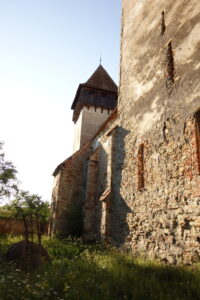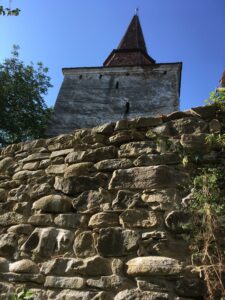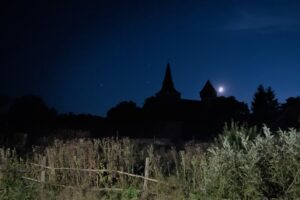
View of the church and village of Movile in Transylvania, Romania. © Agata Walczak
The evening is chill as we enter the village. We can hear the rising wind, for it moans and whistles through the households. As the twilight grows it begins to get colder. Each moment I expect to see the light from a street lamp or at least the glare of a candle in the window, but all is dark and shrouded in mist. Somewhere far down the road, a dog begins to howl to the moon we cannot see. Now and then we pass a horse wagon driven by a local; it is the only mean of transportation that suits the inequalities of the road leading up the hills. As we move forward and come nearer to this abnormal landform, it seems to us less and less likely to be just a work of nature.
Legend has it, a giant was involved in the creation of this place; one hundred hills were piled up of sand from his pocket. Suddenly I am finally able to see sort of dim lights ahead of us and then out of darkness a silhouette of a tall, soaring building emerges. Its thick stone walls leave almost no room for windows; its mighty towers stand out against the moonlit sky. A castle? No, a church. A fortified church that opens its gates to the weary wanderers.
This scene could successfully be an introduction to a gothic novel or a horror story. Add Transylvania as a location and you will have a full picture, for we all associate this region with a place of terror where danger awaits at every step; all thanks to one 19th-century Irish writer who created Dracula. Nonetheless, I can assure you, dear reader, that this story does have a happy ending since it happened to me… twice.
In 2021 and 2022 I had the privilege to participate in a volunteer project ‘Conservation of a medieval wall and adaptation of a tower ruin’ jointly organised by European Heritage Volunteers and the Churchfortress Association in the village of Movile. The church, which overlooks the village, is the work of Saxon settlers who populated this area for about 900 years. Here, as in over 250 similar cases, the church ensemble was transformed into a fortress. Reinforced with two ring walls and defensive towers, it become one of many fortified churches characteristic to the region. During repeated raids and attacks that had plagued Southern Transylvania in the Middle Ages, the villagers could seek refuge behind the walls.

One of the sides of the fortified church. © Agata Walczak
Nowadays the church no longer performs sacral or military functions. No one takes shelter inside but birds and tourists running away from the rain. The Saxons are almost gone; those who remained are too old and too weak to take care of the monument. The fortified churches have been a striking feature of the Transylvanian landscape for many centuries. Yet it was likely that the neglected building will soon fall into disrepair or even collapse as happened to the churches of Roades and Rotbav in 2016.
Fortunately, there were people who proved true that ‘a friend in need is a friend indeed’. They have even founded Churchfortress e.V. Friends of Hundertbücheln – Movile Association, which has been actively working towards the preservation of the ensemble since 2015. Most of the time it means simply hard physical work, which the Association members undertake personally with the possible help of volunteers. The cooperation established between the Association and European Heritage Volunteers resulted so far in two summer projects. A total of four weeks of work gave satisfactory results: the collapsed part of the inner ring had been reconstructed; the wooden staircase leading through the gate tower and its support beams had been repaired and secured; eventually the old-style rainwater drainage system replaced the concrete one.
Nonetheless, the main hero of our story would not be the church itself. Although the maintenance of the ensemble is a focal point of the Churchfortress’ activity, as a team of professional landscapers and ecologists they recognise not only the historical but also environmental, social and aesthetical values of the extraordinary surroundings. To paraphrase their own words, the fortified church used to be both the spatial and social centre of the rural community; that is why bringing back life to the village should be a matter of equal importance. Years of communism in Romania left behind many broken communities and large parts of the countryside still have to deal with problems such as limited access to quality education, lack of career prospects and public transport exclusion. Every summer lots of people go west after seasonal jobs. During this time, their farmlands lie fallow since there is no one to work there. Movile is not an exception.
Located on the southern side of Hârtibaciu Valley, the village is also called the ‘place of a hundred hills’ (germ. Hundertbücheln). The name derives from the numerous hillocks on the eastern outskirts. You can meet various theories about how the hills were formed (including the one of a sand-spreading giant). Their origin has not yet been scientifically explained; to be fair, the hills do not look one hundred per cent like a natural relief. It is known, however, that grasslands covering the hills are home to many rare species of animals and plants. This unique landscape has remained untouched by people for ages, but if not properly protected, it may be irreversibly damaged by industrialisation and intensive agriculture. Unfortunately, this terrain is already attracting foreign investors and the owners tend to sell the land that has belonged to their families for generations for the prospect of improving their financial situation.

Outer wall protecting the fortified church. © Agata Walczak
The objectives that were set out by the Churchfortress Association in this regard are to invigorate the village economy and to ensure that residents have alternative sources of income. This can be achieved through sustainable development based on ecotourism, small-scale manufacturing, handicraft, and traditional agricultural methods that had been practiced here for decades.
Farming, breeding and pastoralism are the core occupations in this region; every morning and evening you can spot the herd of cows heading towards the hills. Sadly, each year there are fewer and fewer heads. If the herd is not big enough, the herdsman’s work does not pay off. To support the herd, the Association bought two cows and gave them under the care of a neighbour.
The cows are milked every day and fed with hay cut locally near the village; in spring and summer, they join the herd on the way to the pasture. That way the milk collection centre can continue supplying the community with milk, and the caretaker receives money from the sale. The volunteers and tourists staying in the village can, on the other hand, enjoy the taste of fresh milk, locally-produced cheese and other dairy products.
Speaking of local goods, it is remarkable that the food during our projects was almost entirely provided by farmers and neighbours. We start the morning with scrambled eggs, freshly picked from laying hens; we eat it with a giant slice of crispy crust bread, baked the evening before; we can put zakuska – an eggplant spread – on it, but we also have a great selection of homemade jams to choose from, a never-ending jar of summer blossom honey and the sweetest tomatoes earth has ever yielded.
Later on fruit preserves, pickles, zakuska and honey, along with homemade beeswax cream, propolis and herbal tea blend will be packed and labelled as Movile-Boxes. One box contains about ten delicious specialities, natural healing products and other small surprises; all items have been purchased for a fair price from local manufacturers and will be resold online during Christmastime. Each subsequently sold box contributes to the preservation of the smallholder’s traditional way of life and the development of their own production.
For lunch and dinner, traditional Romanian dishes are served; we have an opportunity to taste stuffed cabbage rolls called sarmale, supă cu găluşte – a soup with cornmeal dumplings and different types of ciorbă – a thick soup or stew usually served with sour cream (smântână). On special occasions, Doina and Ana, our cooks living next door, bake a cake (or two) using plums and apples gathered from the parish garden.
The orchard located at the foot of the church is truly phenomenal. Over a hundred different fruit trees can be found there, predominantly old varieties – the ones you cannot buy in markets. A few years ago the Association members took up the challenge of mapping and marking all species. There is one rule in the garden: you must not shake the trees. If you want the fruits, feel free to gather those from the ground. We make an apple pie from the bruised apples, the leftovers from the breakfast go to the pigs.

The church and village by night. © Agata Walczak
Under the watchful eye of the Church fortress team, nothing is wasted. You can almost feel like in Saxon times. Hundreds of years ago the anonymous builders, standing in the face of a looming threat, would not allow themselves to be picky. They used stones found in the surrounding area to erect the church ensemble; and so did we to plaster the breach in the wall, respecting traditional masonry techniques under the guidance of regional heritage specialists.
While working on the access trail leading through the gate tower, we kept the same principles. Bricks from a nearby ruin turned out to be a perfect material for a solid foundation. Although most of the old oak stairs had to be removed because of their rottenness degree, we tried to save as much wood as possible to be restored and reinserted along with new beams.
It is not a big deal to renovate something quickly, using cheap materials or concrete a drain that will crack soon; the trick is to build something that will last for another few centuries. Yes, it may take a while to produce one thousand hand-made roof tiles. But if they come from a historical tile manufactory located in the heart of Hârtibaciu Valley, it is worth waiting. Especially because by purchasing them you support local craftsmen and the tower you are renovating will not be standing out with artificial colour and shapes too ideal to be real.
Considering heritage protection laws, it is necessary to use materials which do not harm the original structure. What I learned is that it is also important for the reconstructed parts to harmonise with the scenery, particularly if you have to handle a cultural landscape that remained untouched for ages. From my point of view, it is safe to say that the Churchfortress Association mastered that art. Even though there is still a lot of work ahead of them, their actions already affect the life of the village in the most positive of ways. You ought to see the smiling faces of the neighbours who stop by the church gate almost every day to take a look at work progress and cheer their friends. Mai poti? they ask. Can you do more?
By Agata Walczak, historian, heritage & cultural tourism specialist.





Follow us: